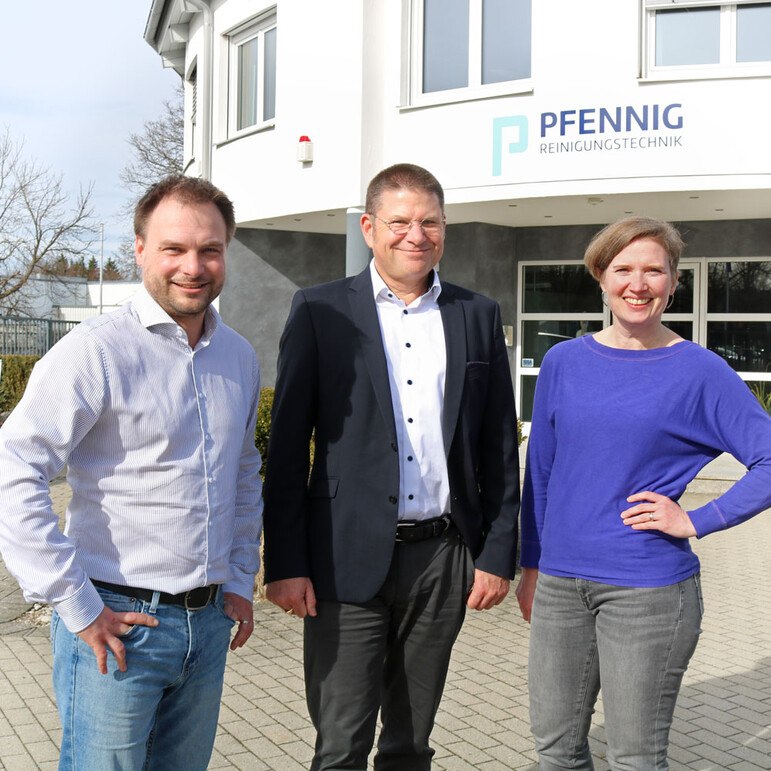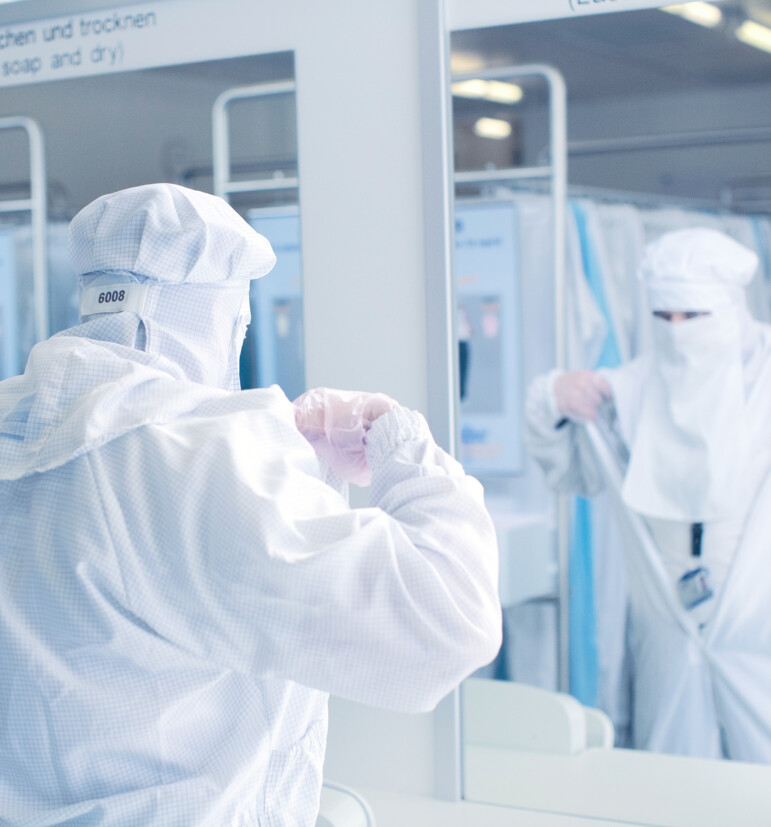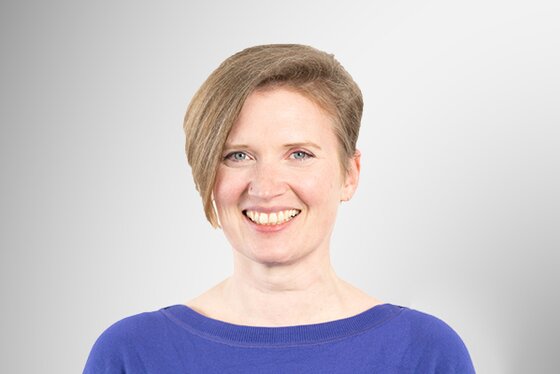
Cleanroom cleaning at Dussmann
Just don’t stir up any dust
Even the best cleanroom is only as good as the people who work there. At Dussmann, regular employee training is an important part of quality assurance.
In cleanroom settings, where state-of-the-art technologies and sterile processes set the tone, there is no room for compromise: Dust particles, bacteria, and viruses – all of these invisible enemies can jeopardise sensitive products and research projects. That’s why the number of particles cannot exceed the threshold values set by law. And that is exactly where the cleanroom cleaning teams from Dussmann Facility Management come into play. “They do much more than just visible ‘cleaning.’ They combine precision, know-how, and rigorous hygiene in their day-to-day work – all in line with our motto, ‘We care for more’”, says Gudrun Schaulinski, Head of Business Development at Dussmann. She is responsible for expanding various fields of business at Dussmann Service Germany. In addition to inquiries from the field of building cleaning, she also deals with further development and evolution in the area of food services. “Demand for professional cleanroom cleaning is rising steadily. The European microchip industry is expanding, especially in Germany, driven by the funding the EU is providing for semiconductors. More and more cleanrooms are being set up to manufacture chips for cars, household appliances, and smartphones.”
To expand on her own expertise, Schaulinski attended a cleanroom workshop at the start of this year with Fabian Maluck, Head of Sales Germany at Dussmann. Together with Dussmann employees from building cleaning and sales, they got to know the theoretical and practical workflows involved in a fully functional training cleanroom operated by Pfennig Reinigungstechnik in Kempten, in Bavaria’s Allgäu region.
Cleaning and disinfection of cleanrooms has been a part of the Dussmann portfolio since 2003. In Germany, Italy, Austria, Switzerland, Luxembourg, Poland, the Czech Republic, Hungary, Romania, Estonia, Lithuania, and the United Arab Emirates, specially trained Dussmann employees clean everything – even if it already looks clean.

Precision work on the micro scale
Inside a cleanroom, the microorganisms in the air and on surfaces are not visible to the naked eye. These microscopic particles could pose a danger to the sensitive products manufactured in cleanrooms, whether they are microchips, optics, or medications.
“A single particle of dust can impair a computer chip’s functioning, or a single bacterium might endanger a medication’s purity”, explains Dietmar Pfennig, owner and managing director of Pfennig Reinigungstechnik. And that means in many industries – including the semiconductor, biotechnology, pharmaceuticals, medical technology, and microelectronics sectors – having a clean process environment is crucial to the quality of the products made in that environment.

Dussmann Facility Management views regular training as the centerpiece of effective cleanroom cleaning. Maluck explains: “These seminars are how we maintain our stringent standards of quality for cleanroom cleaning at Dussmann. Trained cleaning professionals are also more efficient in their work.” At the same time, these activities also give cleanroom cleaners a way to stay up to date on specifications and standards, deepen their knowledge of how to prevent contamination, and practice working with cleaning equipment.
Cleaners working inside cleanrooms wear protective coveralls, gloves, face masks, and special shoes so they bring as few particles as possible in with them. The process of donning this special clothing is time-consuming in itself, depending on the type of cleanroom. The order of steps is specified in meticulous detail, proceeding from top to bottom, since the head is where the most particles – such as hairs and flakes of skin – are located. The most glancing contact between the coveralls and floor requires that the coveralls be changed and the dirty ones sent immediately to a special laundry for cleaning. Cleanroom clothing is taken off in the opposite order.
After changing, Dussmann cleaners enter airlocks that minimise the impurities brought into the cleanroom from outside. Equipment is disinfected and floors, walls, and ceilings wiped using cleaning textiles that capture even the tiniest particles. This cleaning process is fundamentally different from conventional building cleaning: Movements that are too rapid would stir up too many particles. This means wiping a single square meter of floor or cleaning the same size tabletop can take about three times as long as with conventional interior cleaning.
Invisible and indispensable
In the seminar, participants also learn to keep talk to a minimum while working in cleanroom settings, since this helps reduce the risk of aerosol contamination. Occupational safety and health are also covered as topics, as hazardous materials are often used in cleanrooms. Last but not least, ongoing continuing and professional education also helps enhance employee motivation. “They often don’t get the sense of accomplishment from a job well done in their day-to-day work, since when their work is done right, it isn’t immediately visible,” Schaulinski says.
The training sessions are aligned individually toward the requirements and circumstances of Dussmann’s clients. The quality of the cleaning provided is ultimately checked using UV lamp tests, microbiological tests, contact samples, and measurements of the particulate load in the air. However, in the 20 years that Dussmann has been providing cleanroom cleaning services, there has been nothing to complain about. The stringent standards that apply in this sector have been upheld at all times.

Advice on cleanroom cleaning
Want to learn more about cleaning and disinfection across all cleanliness classes in sterile and dust-free production? Need advice on cleanroom cleaning? We’re here to help!
